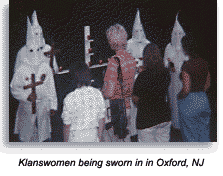The simple facts about the birth of the Ku Klux Klan and its revival a half century later are bewildering to most people in today's modern society. The first efforts to revive the Ku Klux Klan after World War II were unsuccessful. Dr. Samuel Green of Georgia led attempts to reorganize the Klan and even succeeded in several states, but the Klan splintered and many states adopted specific anti-Klan legislation.
As a reaction to growth of the Civil Rights Movement in the 1950s, several groups describing themselves as Klans rose in the South, although there was never the unified structure that characterized either of the first two Klan organizations. One of those was the White Knights of the Ku Klux Klan, led by Robert Shelton. It had considerable influence in Mississippi. Klansmen were implicated in the bombing of the 16th Street Baptist Church in Birmingham and in the murder of three civil rights workers in Mississippi in the summer of 1964. Klansmen were later convicted of those crimes, but the Klan itself was not directly affected.
Following the passage of the Civil Rights Act of 1964, blacks gained a measure of political power in the South, and the Klan gradually became marginalized. Eventually, legal actions in civil courts sharply curtailed what remained of the organization.
In 1981, a black man was put on trial in Mobile, Alabama, for the murder of a white policeman. The jury, which included several blacks, was hung. Afterwards, Bennie Hays, a high-ranking Klansman in Alabama, said, "If a black man can get away with killing a white man, then we ought to be able to get away with killing a black man."
On March 21, 1981, Bennie Hays' son, Henry Hays, and James Knowles found 19-year-old James Donald walking to his home in Mobile and took him to the next county, where they lynched him. In 1983, Knowles was found guilty of violating Donald's civil rights and was sentenced to life imprisonment. When Henry Hays was brought to trial, Knowles testified for the prosecution. Hays was convicted of murder and sentenced to death. When he was eventually executed in 1997, he was the first white man to suffer capital punishment for a crime against a black person since 1913.
In co-operation with the Southern Poverty Law Center, James Donald's mother, Beulah May, sued the United Klans of America for their responsibility in her son's death. After a trial that began in February 1987, an all-white jury found the United Klans responsible and ordered them to pay $7 million. As a result, the Klan was forced to give up all of its assets in Alabama, including its headquarters in Tuscaloosa.
Further legal reverses followed. On April 4, 1987, a march marking the anniversary of Martin Luther King Jr.'s assassination was attacked by a white mob in Forsyth County, Georgia. The marchers sued the Southern White Knights of the Ku Klux Klan and the Invisible Knights of the Ku Klux Klan, who operated in Georgia and Louisiana, respectively. In October 1988, a jury awarded nearly a million dollars in damages. When the Invisible Empire finally paid its share, it was forced to disband.
 The Klan has not entirely disappeared. Though currently suffering its worst decline since the 1940s, America's oldest hate group continues to operate on a local level, in some instances still participating in illegal acts of violence and intimidation. Local Klan factions active today are based in North Carolina, Pennsylvania, Arkansas, Texas, and Michigan. An organization called the Imperial Klans of America, Knights of the Ku Klux Klan, condemns violence, but states on its website that it seeks Aryan men and women who will make the world clean and pure.
Membership in Klan organizations is now thought to number only in the thousands. American society as a whole has become more racially inclusive, thus the Klan has once more become marginalized.
The Klan has not entirely disappeared. Though currently suffering its worst decline since the 1940s, America's oldest hate group continues to operate on a local level, in some instances still participating in illegal acts of violence and intimidation. Local Klan factions active today are based in North Carolina, Pennsylvania, Arkansas, Texas, and Michigan. An organization called the Imperial Klans of America, Knights of the Ku Klux Klan, condemns violence, but states on its website that it seeks Aryan men and women who will make the world clean and pure.
Membership in Klan organizations is now thought to number only in the thousands. American society as a whole has become more racially inclusive, thus the Klan has once more become marginalized.